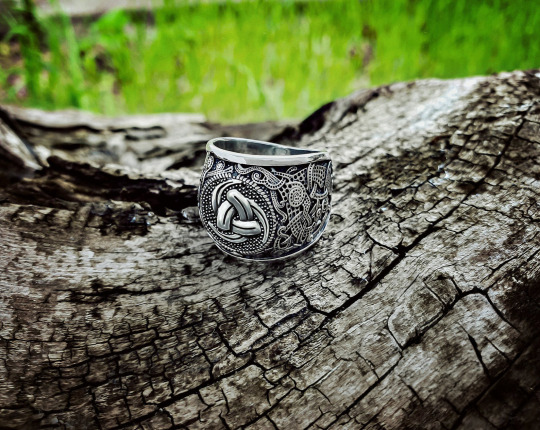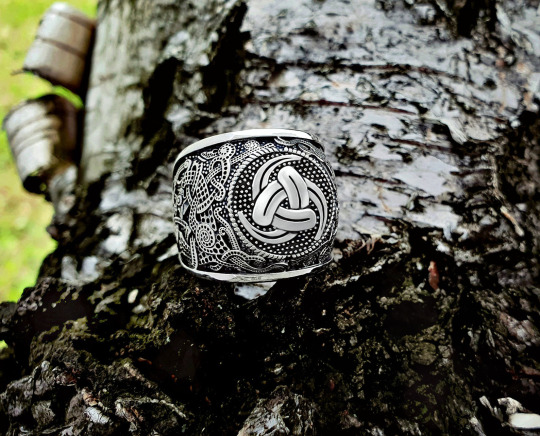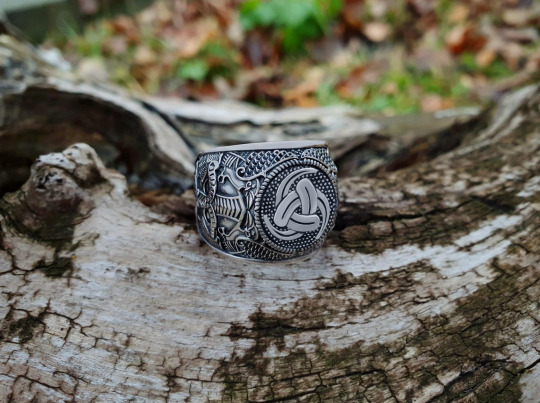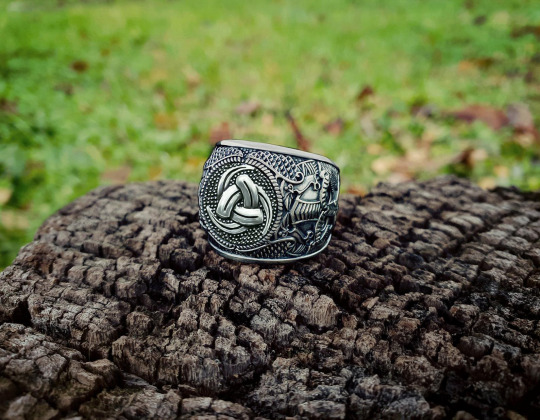#OdinsBlessing
Text




Odin pendant
★Material: High Quality Solid 960 Sterling Silver★
◉ Small Odin Pendant:
Weight: approx. 7,5 grams (0.26 oz)
Height: 32 mm (1,25 inches)
One-sided Odin Necklace
◉ Medium Odin Pendant:
Weight: approx. 17 grams (0,37 oz)
Height: 43 mm (1,7 inches)
One-sided Odin Necklace
◉ Large Odin Pendant:
Weight: approx. 24 grams (0,84 oz)
Height: 50 mm (1,96 inches)
One-sided Odin Necklace
The Odin Pendant is a unique and rare piece of Viking-inspired jewelry that showcases a fusion of two distinctive Viking art styles - the Borre Style and the Jelling Style, both dating back to the 9th and 10th centuries in Norway.
This remarkable pendant features intricate details of Odin, a prominent deity in Norse mythology, who is associated with wisdom, war, and magic. Odin is often depicted with his iconic ravens, Huginn and Muninn, as well as his loyal wolves.
The pendant is crafted from sterling silver, exemplifying the skillful craftsmanship of Viking replicas. It serves as a symbolic representation of Odin's connection with his ravens and wolves, which played essential roles in delivering messages and accompanying him on his journeys.
The Borre Style, named after the site of Borre in Norway, is characterized by its intricate interlacing patterns and animal motifs, which are often intertwined with elements of Viking mythology and spirituality.
The Jelling Style, named after the Jelling stones in Denmark, is known for its more restrained and stylized designs, featuring prominently runic inscriptions and depictions of powerful animals, often serving as symbols of strength and protection.
The fusion of these two iconic Viking styles in the Odin Pendant creates a truly special and rare piece of jewelry, bridging the artistic traditions of two distinct Viking eras. It serves as a tangible link to the rich cultural heritage of the Vikings, embodying their beliefs, artistry, and reverence for powerful deities like Odin.
For enthusiasts of Viking history and culture, wearing this pendant is a meaningful way to carry a piece of this ancient legacy with them, embracing the wisdom and strength associated with Odin, the majesty of his ravens, and the loyalty of his wolves. The Odin Pendant stands as an exceptional representation of Viking artistry and mythology, making it a cherished addition to any collection of Norse-inspired jewelry.
#Borrestyle#Jellingstyle#vikingjewelry#exclusivejewelry#likeaviking#vikingstyle#norse#handmade#Odinpendant#Odinwithravens#ravenspendant#ravens#Odin#silverpendant#vikingdesign#vikingart#pendant#silverjewelry#vikings#handmadejewelry#OdinPendant#NorseJewelry#ScandinavianStyle#VikingAccessories#HandcraftedPendant#OdinsBlessing#VikingCulture#MythologicalInspiration#NorseMythology#VikingArt
1 note
·
View note
Photo

Not gonna stay awake till midnight....already sleepy....soooo #HappyNewYear #NewYearsEve2020 #2020NewYear #odinsblessings #skol (at Newalla, Oklahoma) https://www.instagram.com/p/B6wv3pTnXY4/?igshid=1xc25apjbrt9r
0 notes
Text



Odin horn ring
Metal: sterling silver (925)
Weight: approx. 17 g (0,59 oz)
Viking axe from Mammen.
In 1868 a farmer began to dig into the mound Bjerringhøj at Mammen near Viborg. During this work he chanced upon an unusually richly-furnished grave, which has become known as the grave from Mammen. A magnate was buried in the grave during the winter of 970-71 AD. He was given an expensive costume, a ceremonial axe with inlaid silver decoration and a large wax candle.
On one side a tree motif can be seen. It may symbolise the Christian Tree of Life or the pagan tree Yggdrasil. On the other side is an animal figure – perhaps the rooster Gullinkambi (Old Norse “golden comb”) or the Phoenix. According to Norse mythology Gullinkambi sits on top of the tree Yggdrasil. Here it wakes the Viking warriors every morning and it will crow at the beginning of Ragnarok (the end of the world).
The Triple Horn of Odin holds a sacred place as a symbol within the ancient Scandinavian Viking culture, representing the divine presence of the revered god Odin. This emblem, comprised of three interlocking horns, carries deep significance, embodying the strength, authority, and wisdom associated with Odin. Each horn, symbolizing the consumption of wine, serves as a tangible reminder of power and potency. Yet, beyond its physical representation, the Triple Horn of Odin encompasses a profound metaphor, signifying the eternal pursuit of knowledge and the unending thirst for discovery.
#vikingjewelry#exclusivejewelry#likeaviking#vikingstyle#norse#vikingring#ring#Triplehornring#Triplehorn#Odinring#handmade#silverring#Odin#Mammen#mammenstyle#silverjewelry#vikings#handmadejewelry#OdinHornRing#NorseJewelry#ScandinavianStyle#VikingAccessories#HandcraftedRing#OdinsBlessing#VikingCulture#MythologicalInspiration#NorseMythology#VikingArt#NordicDesign#HornSymbol
0 notes
Text




Odin horn ring
Metal: sterling silver (925)
Weight: approx. 17 g (0,59 oz)
Within the realm of Scandinavian Vikings, the Triple Horn of Odin reigned as a prominent pagan symbol, epitomizing the divine presence of the revered Norse deity, Odin. This emblem, comprised of three interlocking horns, held deep significance and served as a visual representation of Odin's might and sovereignty. The triple horn, commonly associated with wine, evoked connotations of strength and power, encapsulating the essence of Odin himself. Moreover, the symbol carried a profound message, embodying the relentless pursuit of wisdom, knowledge, and the thirst for discovery.
Steeped in ancient mythology, the origins of the Triple Horn of Odin can be traced back to the captivating saga surrounding Odin's quest for the legendary mead known as Odhroerir/Óðrerir, also known as the Mead of Poetry. The myth tells of a significant accord between the gods of Asgard and Vanhaem, aiming to resolve their conflicts through peaceful means. To solemnize this agreement, the divine beings contributed their saliva to a communal vat, giving rise to the awe-inspiring figure of Kvasir, renowned for his unparalleled wisdom and sagacity.
However, tragedy befell Kvasir when two conniving dwarves schemed his demise, extracting his life essence to create an extraordinary elixir. By combining the divine blood with honey, they fashioned a magical concoction capable of endowing those who partook in its consumption with the gift of poetry and wisdom. To safeguard this enchanted honey, the dwarves meticulously stored it within two vats named Son and Bodn, accompanied by a revered cauldron named Odrerir.
Driven by an insatiable quest for enlightenment, Odin, the supreme leader of the gods, embarked on a relentless journey to acquire this coveted honey. After an arduous search, he eventually stumbled upon the sacred cauldron, consuming its entire contents while simultaneously draining the two accompanying vats. Transfiguring into the majestic form of an eagle, Odin soared towards the celestial realm of Asgard, evading any potential threats or adversaries that might impede his pursuit.
This captivating myth left an indelible imprint upon Viking culture, permeating their customs and traditions. It ignited the popularity of mead, an intoxicating beverage crafted from the fermentation of honey and water, which became synonymous with their celebrations and rituals. Furthermore, the use of drinking horns became intrinsic to Viking practices, serving as vessels for the revered mead and playing a central role in ceremonial toasts. Consequently, Odin's triple horn became an iconic symbol, forever entwined with the transformative power of honey, embodying the realms of wisdom and poetic inspiration that it unlocked.
#vikingjewelry#exclusivejewelry#likeaviking#vikingstyle#norse#vikingring#ring#handmade#Odinmask#Odin#Triplehornring#Triplehorn#Odinring#Hugin#Munin#silverring#silverjewelry#vikings#handmadejewelry#OdinHornRing#NorseJewelry#ScandinavianStyle#VikingAccessories#HandcraftedRing#OdinsBlessing#VikingCulture#MythologicalInspiration#NorseMythology#VikingArt#NordicDesign
0 notes